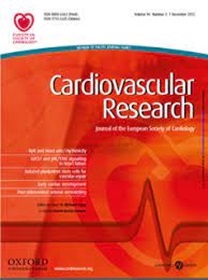右星状神经节刺激对急性左侧心室缺血心律失常的调节作用
IF 13.3
1区 医学
Q1 CARDIAC & CARDIOVASCULAR SYSTEMS
引用次数: 0
摘要
目的急性心肌缺血可引起致死性心律失常。左星状神经节刺激(LSGS)调节损伤电流,并在左前心室壁缺血时引起心律失常。右星状神经节刺激(RSGS)在心律失常发生中的作用尚不清楚。我们假设,在左室壁缺血时,RSGS是心律失常。方法和结果对11只麻醉母猪进行左室外壁单极心外膜电图测量。旋转冠状动脉(CX)闭塞造成7次急性缺血(5分钟),间隔20分钟再灌注。第二次闭塞作为对照。第三次闭塞期缺血3分钟后,启动LSGS 30秒。第4次闭塞时行RSGS。左、右星状神经节和迷走神经去中心化后,启动LSGS和RSGS(第6和第7闭塞)。缺血时RSGS比LSGS或对照组更容易致心律失常,自发性室性早搏较多(缺血3-5分钟),2例心室颤动。在CX闭塞缺血3分钟的心肌中,lgs诱导的复极效应不存在。结论缺血心肌不存在lgs诱导的复极缩短。cx闭塞后RSGS比LSGS或对照组更容易致心律失常。这些数据表明,RSGS或LSGS对心律失常的影响取决于缺血区的位置,这支持了双侧交感神经切除术优于单独左侧交感神经切除术的临床发现。本文章由计算机程序翻译,如有差异,请以英文原文为准。
Right stellate ganglion stimulation modulates arrhythmogenesis in acute left lateral ventricular ischemia
Aim Acute myocardial ischemia causes fatal arrhythmias as result of a flow of ‘injury current’. Left stellate ganglion stimulation (LSGS) modulates the injury current and is arrhythmogenic during left anterior ventricular wall ischemia. The role of right stellate ganglion stimulation (RSGS) in arrhythmogenesis is unclear. We hypothesized, that RSGS is proarrhythmic during left lateral ventricular wall ischemia. Methods and results In 11 anesthetized female pigs, ventricular repolarization was measured in unipolar epicardial electrograms from the left lateral ventricular wall. Seven subsequent episodes of acute ischemia (5 minutes) were produced by occlusion of the circumflex coronary artery (CX), separated by 20 minutes of reperfusion. The second occlusion served as a control. After 3 minutes of ischemia during the third occlusion, LSGS was initiated for 30 seconds. In the 4th occlusion, RSGS was performed. After decentralization of both left and right stellate ganglia and vagal nerves, LSGS and RSGS were initiated (6th and 7th occlusion). RSGS during ischemia was more arrhythmogenic than LSGS or control with more spontaneous ventricular premature beats (3-5 minutes of ischemia) and 2 instances of ventricular fibrillation. The LSGS-induced effect on repolarization was absent in myocardium that had been ischemic for 3 minutes by CX occlusion. Conclusions LSGS-induced repolarization shortening is absent in ischemic myocardium. RSGS was more arrhythmogenic following CX-occlusion than LSGS or control. These data demonstrate that the arrhythmogenic influence of RSGS or LSGS is contingent on the location of ischemic zone supporting the clinical findings that bilateral sympathectomy is superior to left sympathectomy alone.
求助全文
通过发布文献求助,成功后即可免费获取论文全文。
去求助
来源期刊

Cardiovascular Research
医学-心血管系统
CiteScore
21.50
自引率
3.70%
发文量
547
审稿时长
1 months
期刊介绍:
Cardiovascular Research
Journal Overview:
International journal of the European Society of Cardiology
Focuses on basic and translational research in cardiology and cardiovascular biology
Aims to enhance insight into cardiovascular disease mechanisms and innovation prospects
Submission Criteria:
Welcomes papers covering molecular, sub-cellular, cellular, organ, and organism levels
Accepts clinical proof-of-concept and translational studies
Manuscripts expected to provide significant contribution to cardiovascular biology and diseases
 求助内容:
求助内容: 应助结果提醒方式:
应助结果提醒方式:


